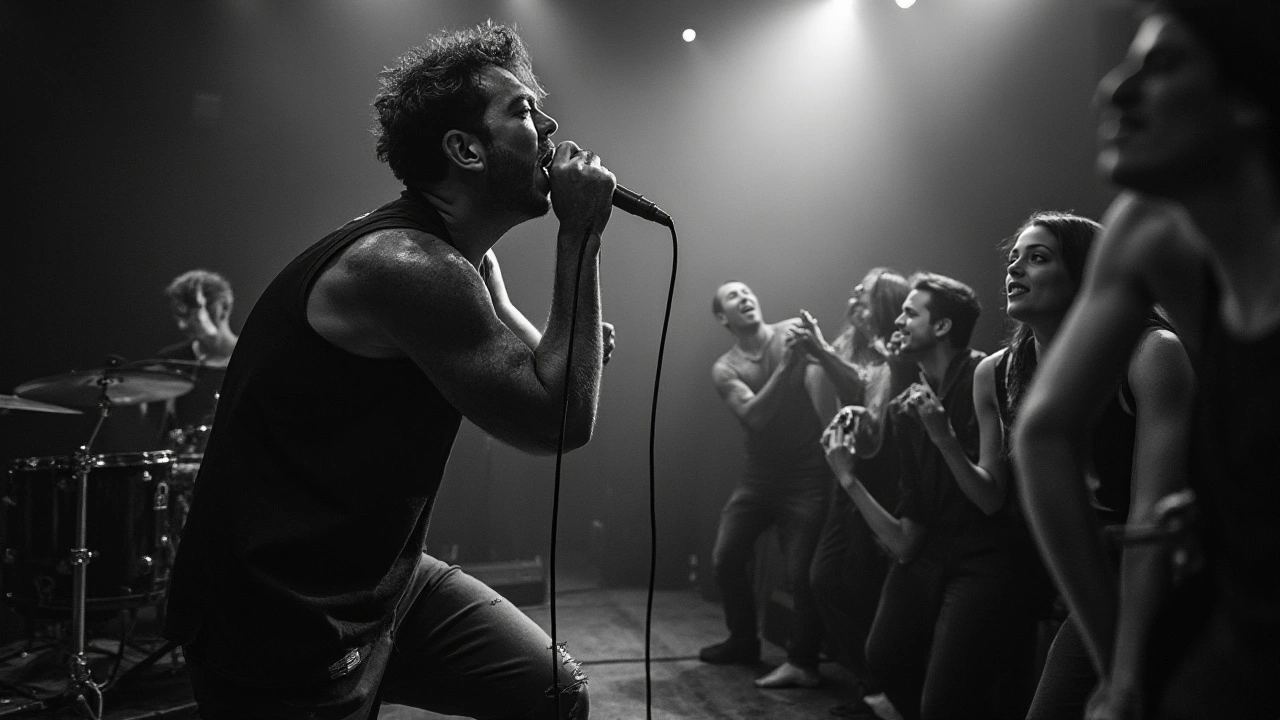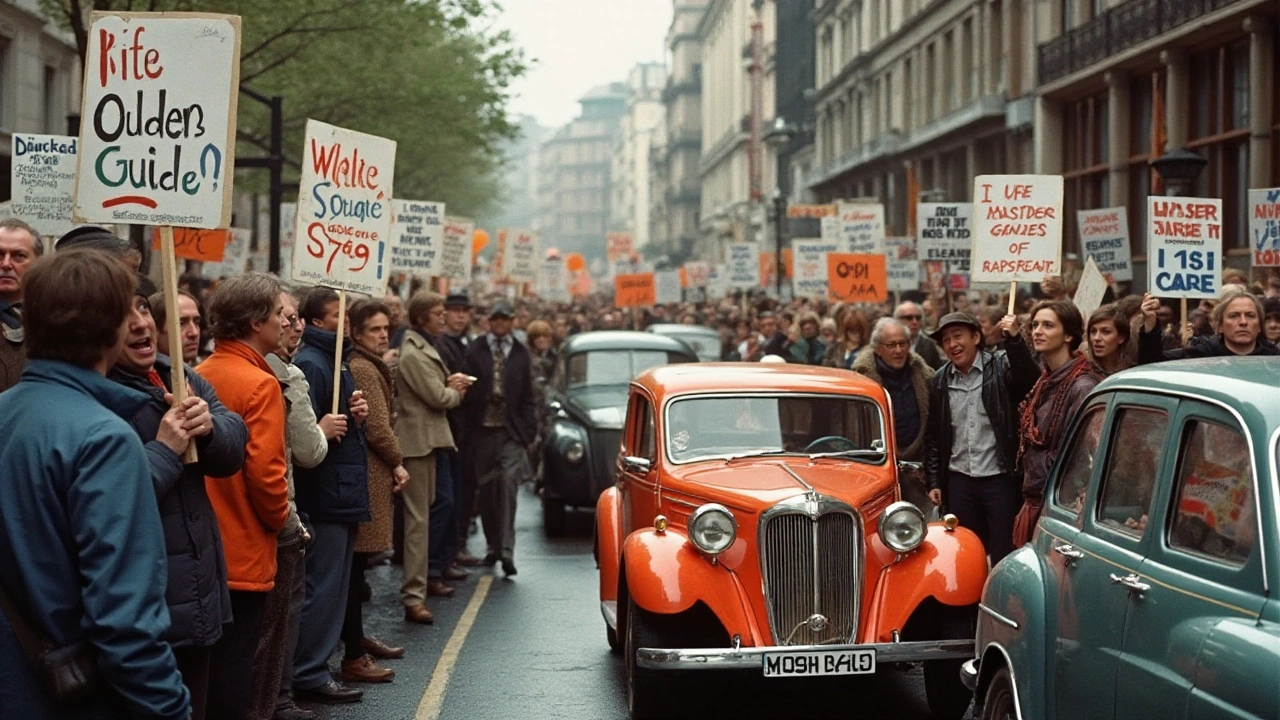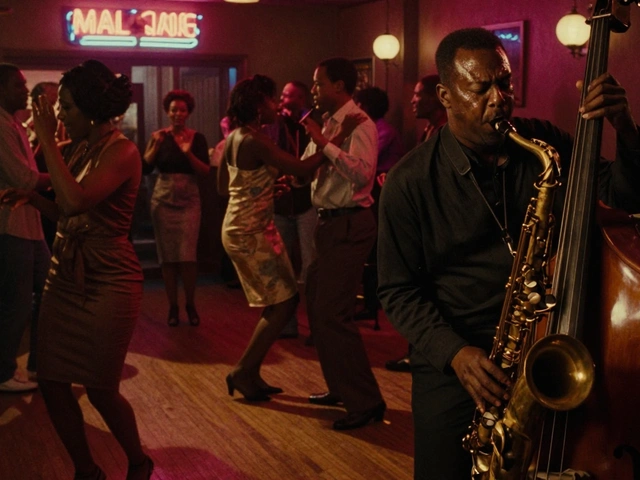Rock music, the genre born out of defiance and youthful energy, has always walked hand in hand with controversy. Over the decades, it has served as a canvas where bold statements and unexpected events unfold, sometimes shocking the audience but perpetually keeping the art form alive and kicking.
With electric riffs and the raw power of live performances, rock music has pushed boundaries both in sound and spectacle. This exploration takes a closer look at those pivotal moments when rock music made headlines, not just for the composition but for its audacious spirit. Get ready to discover the stories behind these daring episodes and the legacy they left on both music and society.
- On-Stage Antics and Shock Tactics
- Lyrical Protests and Political Statements
- Scandalous Album Covers and Visuals
- Personal Lives and Public Meltdowns
On-Stage Antics and Shock Tactics
Rock music has always thrived on its ability to captivate and sometimes even shock the audience, making performances not just about the music but an intense visual and emotional experience. The stage has served as a dynamic platform for rock musicians to push boundaries, often blurring the lines between art and anarchy. One of the most iconic examples of such antics came in 1967 when The Who's Pete Townshend famously smashed his guitar on stage at the Monterey Pop Festival. This act of destruction became a potent symbol of rebellion in the music world, noted for its audaciousness and spontaneity.
Another unforgettable moment occurred in 1972, when Alice Cooper, a name synonymous with shock rock, introduced theatrical horror elements into his stage performances. Executions by guillotine and electric chair, along with a boa constrictor draped around his neck, were among the tricks Cooper used to entertain—and not to mention—horrify his audience. This blend of dramatic theatrics not only redefined what a rock concert could be but also solidified Cooper's status as a pioneering force in the world of shock rock.
The Sex Pistols, known for their raw energy and anti-establishment rhetoric, added an infamous chapter to these edgy performances. During their 1976 tour in the United States, frontman Johnny Rotten taunted his audience with incendiary remarks, often sparking chaos in the crowd. Their confrontational performances were filled with unpredictability, turning every show into a spectacle of rebellion and mayhem. As Rotten put it, "If you’re going to be outrageous, do it with style."
Meanwhile, in the realm of more mystical and ritualistic performances, Led Zeppelin's Page was known for his spellbinding presence. Dressed in flowing robes, he would play his guitar with a bow, creating ethereal sounds that transported audiences into a trance. These performances became legendary, solidifying Led Zeppelin's formidable reputation in rock music history. Page's antics weren't simply for show—they were part of a carefully crafted experience that added a layer of mystery to their music.
In the early 1990s, Nirvana’s Kurt Cobain brought a different kind of intensity to his performances. Known for stages filled with raw energy and occasional nihilism, Cobain would at times destroy his equipment or veer off into distorted renditions of pop songs in a reflection of his rebellious attitude within the grunge movement. His unpredictable stage presence embodied the disillusionment of a generation, becoming a defining characteristic of Nirvana’s live shows.
The world of rock music is ripe with such compelling examples, each act adding a chapter to the colorful tapestry of music history. These antics and shock tactics are not just gimmicks; they have often reflected the ethos and prevailing sentiments of their times, acting as catalysts for cultural dialogue. Whether smashing guitars, engaging in elaborate theatrics, or confronting the audience head-on, these performers have pushed the boundaries of what live shows can convey, forever altering the landscape of rock music.

Lyrical Protests and Political Statements
Rock music has long been regarded as a vehicle for social change, channeling raw emotion and unfiltered viewpoints directly into the public consciousness. Often operating at the crossroads of rebellion and reflection, many musicians have taken it upon themselves to tackle controversial issues head-on through their lyrics. From civil rights to stark anti-establishment sentiments, these musical declarations have sparked dialogue across the globe. The 1960s and 70s saw an unprecedented surge in protest anthems, as iconic artists like Bob Dylan and The Beatles used their influential platforms to challenge the status quo. Transcending mere entertainment, their music provided a rallying cry for generations determined to break free from societal constraints.
Dylan was renowned for his poignant and often biting lyrics. With songs like "The Times They Are a-Changin'," he eloquently captured the zeitgeist of a world on the cusp of transformation. This classic piece wasn't just a song; it was an anthem for the youth, encapsulating the frustration and optimism of a generation eager for change. Meanwhile, The Beatles ventured into politically charged territory with tracks like "Revolution," which questioned the complexities and contradictions of political movements.
In the 1980s, another wave surged as bands like U2 embraced political activism with open arms. U2's "Sunday Bloody Sunday" is one such track, a visceral reaction to the violence and unrest in Northern Ireland. With its driving beat and haunting lyrics, the song captures the heartache and turmoil of innocent lives caught in the crossfire of political strife. Frontman Bono himself has never shied away from using his voice to speak out on pressing global issues, carving a niche for socially responsible rock music.
Punk rock, a genre birthed from frustration and disenchantment, also thrived on political outcry. The Sex Pistols with songs like "God Save the Queen" launched an unrelenting attack on the establishment. Their controversial antics and brash lyrics turned them into a symbol of anarchy for those disillusioned with the system. The visceral intensity with which they delivered their message left an indelible mark on the music industry and society at large.
More recently, Rage Against the Machine took up the mantle, pushing boundaries and lighting a fire under political discourse through their music. Songs like "Killing in the Name" confronted issues from police brutality to systemic racism, and became anthems for activism. Their powerful fusion of hip-hop, metal, and punk was accompanied by an equally potent message, demanding attention and action. As Tom Morello, the band's incendiary guitarist, once stated, "Music has the potential to change the world, but it's not going to change the world just sitting on your phone."
Here's a glimpse at the persistent relevance of political rock music throughout the decades:
| Decade | Artist | Key Song |
|---|---|---|
| 1960s | Bob Dylan | The Times They Are a-Changin' |
| 1970s | The Beatles | Revolution |
| 1980s | U2 | Sunday Bloody Sunday |
| 1990s | Rage Against the Machine | Killing in the Name |
The unyielding spirit of protest songs cements rock music as a potent form of resistance. By daring to voice their perspectives, artists inspire dialogue and reflection, proving that music is not only entertainment, but a powerful catalyst for progress.

Scandalous Album Covers and Visuals
The world of rock music has always embraced a bold and unapologetic style, with album covers often serving as the first glimpse into the wild creative spirit of the genre. Throughout history, several albums have provoked strong reactions due to their controversial visuals. One of the most iconic examples is The Beatles' 1966 "Yesterday and Today" cover, infamously known as the 'Butcher Album,' which depicted the Fab Four in white coats, surrounded by raw meat and decapitated doll parts. This unsettling imagery sparked backlash prompting Capitol Records to withdraw the album and release a more subdued version. But John Lennon, a master of pushing boundaries, defended the decision by claiming it was an artistic protest against the Vietnam War. These bold artistic choices often challenged societal norms, testing the limits of censorship, and leaving an indelible mark on music history.
Another album that left jaws dropping was Nirvana's "Nevermind" released in 1991. The album cover, featuring a naked baby swimming towards a dollar bill on a fishing hook, was bold for its time. It represented the raw, naked ambition that grunge music epitomized. The album visualized what Kurt Cobain felt society was doing—baiting innocence with money. Despite the controversy, it helped propel Nirvana to worldwide fame, leaving a powerful statement about how visuals could convey themes as strongly as lyrics. The juxtaposition of innocence and commercialism in the "Nevermind" cover was a powerful commentary on cultural values.
More recently, Kanye West's supposed rock-inspired album "My Beautiful Dark Twisted Fantasy" from 2010 featured art by George Condo, which portrayed images that were deemed too explicit by some retailers. Kanye, never one to shy from controversy, created several alternate covers for the album. Critics and fans debated whether these covers were meant to challenge societal conventions or simply garner attention, though many appreciated the boundary-pushing art as reflective of the chaotic genius of the album's content. The use of visual art here wasn't merely to shock, but to enhance the album's narrative, adding layers that invited dissection and discussion among its audience.
Looking at the history of scandalous visuals, we can't forget David Bowie's "Diamond Dogs," with artwork by Belgian artist Guy Peellaert. Released in 1974, the cover showed Bowie as a half-man, half-dog creature. The cover's theatrical and eerie design prompted RCA Records to crop the original to avoid the explicit depiction of the dog-man anatomy, yet the cover went on to become a collector's item due to its notoriety. Bowie's penchant for androgyny and shock tactics resonated through the original concept, proving that rock wasn't just about rebellion in sound, but rebellion in sight too.
These scandalous album covers weren't just marketing strategies; they were deliberate reflections of the bands' ethos and societal critiques. Artists used album art as a tool to express their messages boldly, challenging both the industry and its audience. Rock music thrives in these controversies because it embodies a restless energy, always ready to confront the mundane with something extraordinarily daring. Album covers, after all, are the doors to an album's soul, demanding not only to be heard but also to be seen in the rawest light possible.

Personal Lives and Public Meltdowns
In the world of rock music, the boundary between artistry and personal chaos often blurs, giving rise to some of the most vivid tales in music history. This genre, synonymous with rebellion and the pursuit of freedom, has brought artists under the microscope, exposing their personal struggles and triumphs to a fascinated and sometimes critical public. The lives of rock stars have consistently intrigued fans much as their music has, weaving the legends that define rock'n'roll.
Consider the infamous story of Kurt Cobain, the figurehead of grunge movement and lead vocalist of Nirvana, whose life tragically ended amidst a tempest of fame and personal turmoil. Cobain’s ongoing struggle with addiction and the pressures of superstardom painted a poignant picture of the cost of fame. His untimely death at just 27 years old left fans and the music world in shock, impacting the course of the genre significantly. This event not only highlighted issues of mental health in the music industry but also evoked a deep cultural reflection on the idolization of tragic figures.
Another legendary figure whose personal battles unfolded before a global audience was Amy Winehouse. Known for her raw, powerful vocals and unforgettable hits, Winehouse's personal life often eclipsed her musical achievements in media portrayal. Her bouts with addiction and her turbulent relationships were frequent tabloid fodder, overshadowing her immense talent. The world watched as she repeatedly tried to navigate the challenges in her life, a narrative echoed in the lines of her hauntingly autobiographical songs. Winehouse's passing, also at 27, further cemented the tragic narrative of young, troubled musicians in rock history.
"Success is falling nine times and getting up ten," remarked Jon Bon Jovi, shedding light on the resilience many rock stars must find within themselves amidst the chaos.
The case of Axl Rose, the enigmatic frontman of Guns N' Roses, is yet another testament to how a rock star's life can evolve into a public spectacle laden with controversies. Rose's fiery temperament and contentious public feuds, particularly during the band's heyday in the late '80s and early '90s, often threatened to overshadow his innovations in music. Despite numerous challenges, including significant lineup changes and prolonged hiatuses, Rose’s perseverance has kept him as a cornerstone in rock.
The intersection of personal lives and public meltdowns in rock music is not limited to the artists alone. Band dynamics themselves often become fields of complex interaction, sparking both creative synergy and discord. Whether it's the notorious squabbles between members of The Rolling Stones or the much-publicized split of The Beatles, these events have left indelible marks on music's cultural tapestry.
These stories of personal trials and public spectacles are more than cautionary tales; they are reflections of a genre that has historically been at the heart of social turmoil and personal expression. The controversial moments arising from the lives of these stars serve as stark reminders of the price of fame and the fragile human core beneath the rock star facade. These narratives continue to captivate audiences, holding a mirror to their complexities and inviting us to reflect on our own understanding of success, celebrity, and human frailty.






